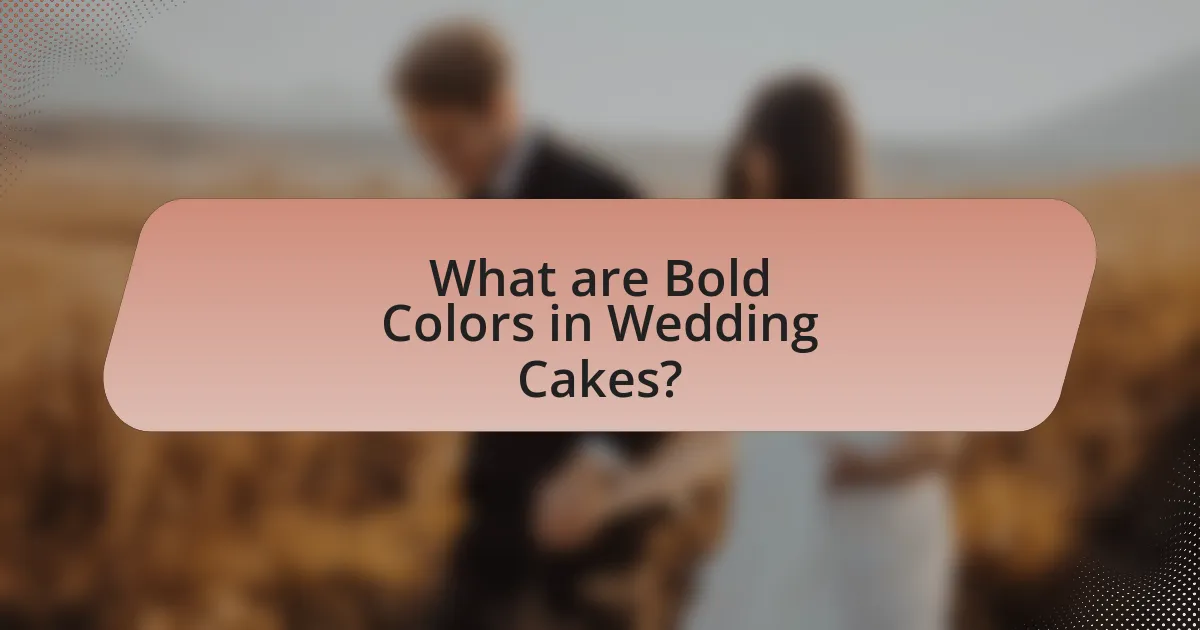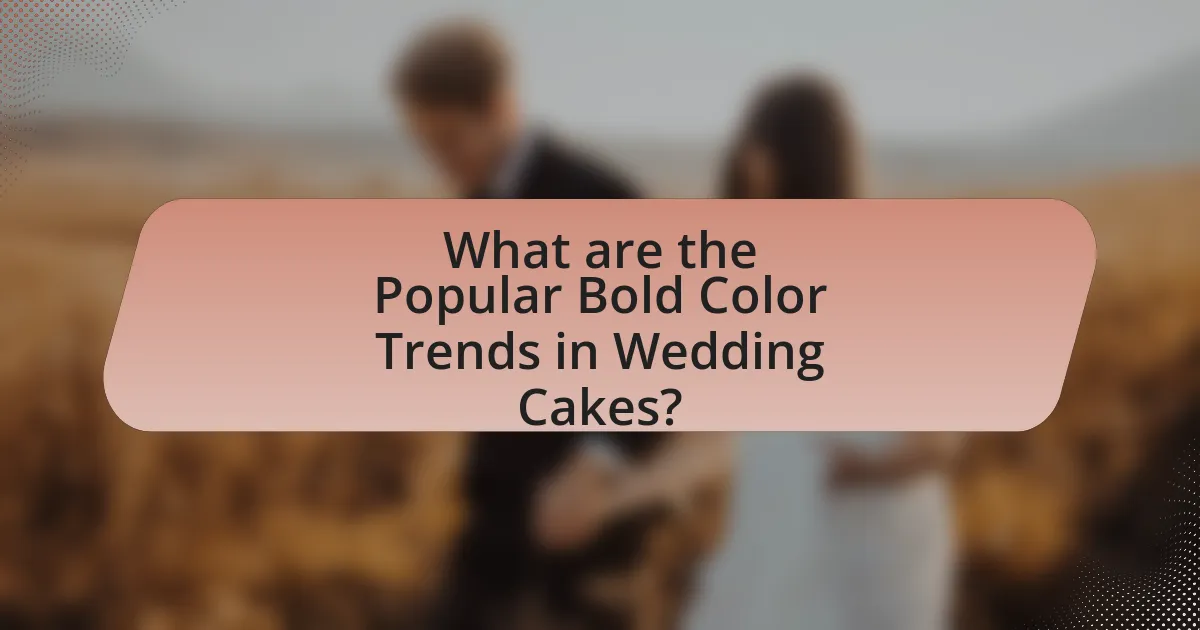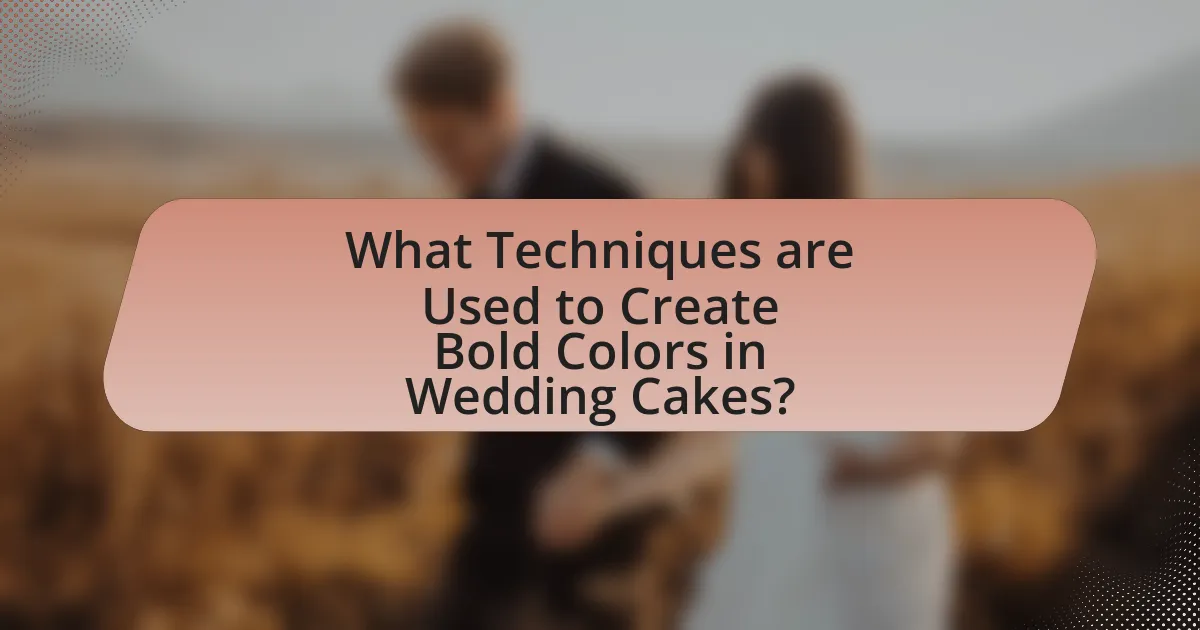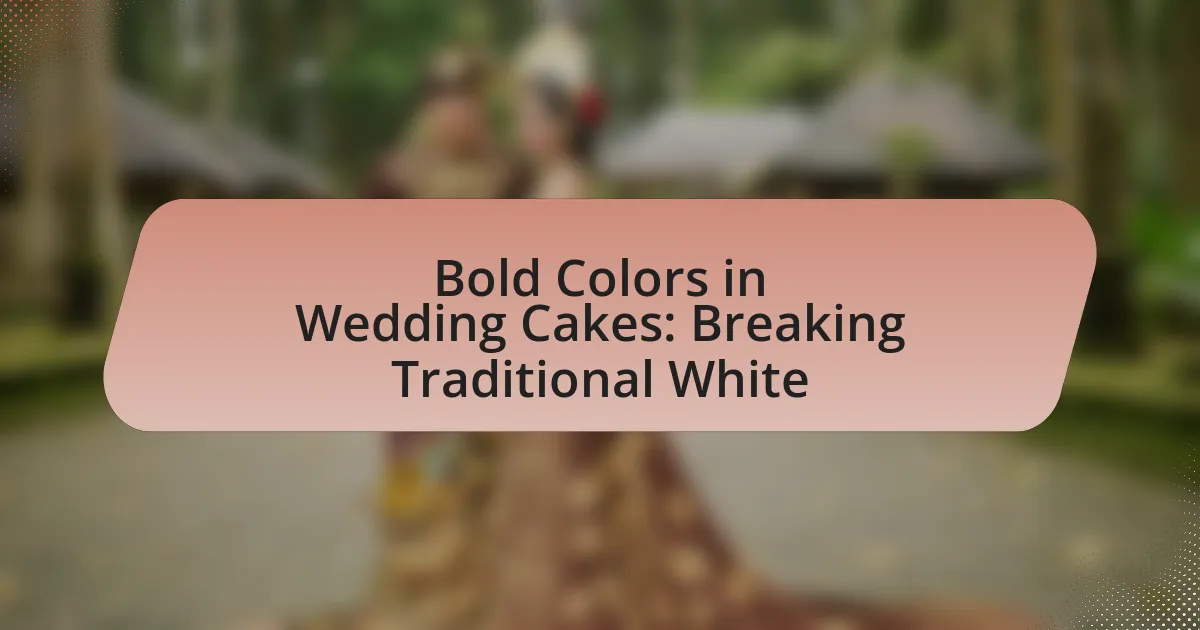Bold colors in wedding cakes represent a vibrant departure from traditional white designs, allowing couples to express their individuality and personal style. This trend has gained traction, with 30% of couples opting for non-traditional color palettes, influenced by cultural practices and the desire for unique celebrations. The article explores how bold colors differ from conventional cakes, the emotional significance they hold, and the techniques used to achieve these striking hues. Additionally, it discusses popular color trends, the impact of seasonal influences, and best practices for selecting and designing bold-colored cakes that enhance the overall wedding theme.

What are Bold Colors in Wedding Cakes?
Bold colors in wedding cakes refer to vibrant, striking hues that stand out prominently against traditional white or pastel cake designs. These colors can include deep reds, royal blues, bright yellows, and rich purples, among others. The use of bold colors allows couples to express their individuality and personal style, moving away from conventional wedding aesthetics. This trend has gained popularity as couples seek to create unique and memorable experiences, with studies indicating that 30% of couples now opt for non-traditional color palettes in their wedding cakes.
How do bold colors differ from traditional white wedding cakes?
Bold colors in wedding cakes differ from traditional white wedding cakes primarily in their visual impact and emotional expression. While traditional white cakes symbolize purity and elegance, bold colors convey vibrancy, personality, and a modern aesthetic. The use of bright hues can reflect the couple’s unique style and theme, making the cake a focal point of the celebration. Additionally, bold colors often incorporate intricate designs and artistic elements, enhancing the cake’s overall appeal and allowing for greater creativity compared to the simplicity of white cakes.
What cultural influences contribute to the use of bold colors in wedding cakes?
Cultural influences such as Indian, Mexican, and African traditions contribute significantly to the use of bold colors in wedding cakes. In Indian culture, vibrant colors symbolize joy and prosperity, leading to the incorporation of bright hues like red, yellow, and green in wedding cakes. Similarly, Mexican weddings often feature colorful decorations and cakes adorned with bold colors, reflecting the festive nature of their celebrations. African cultures also embrace vivid colors in their wedding ceremonies, where colors represent various meanings and emotions, influencing cake designs. These cultural practices highlight the importance of color in expressing identity and celebration during weddings.
How do bold colors reflect personal style in wedding cake design?
Bold colors in wedding cake design reflect personal style by allowing couples to express their individuality and preferences. The choice of vibrant hues can signify a departure from traditional white cakes, showcasing unique themes, cultural backgrounds, or personal tastes. For instance, a couple opting for a deep blue or rich burgundy cake may be emphasizing their love for bold aesthetics or aligning with a specific wedding color palette. This trend is supported by the increasing popularity of custom cake designs, where 70% of couples now choose cakes that reflect their personal style rather than adhering to conventional norms.
Why are couples choosing bold colors for their wedding cakes?
Couples are choosing bold colors for their wedding cakes to express individuality and creativity, moving away from traditional white designs. This trend reflects a broader shift in wedding aesthetics, where personalization and unique themes are prioritized. According to a survey by The Knot, 30% of couples in recent years have opted for non-traditional cake colors, indicating a significant departure from conventional choices. This choice allows couples to incorporate their personal style and wedding color schemes, making the cake a focal point that aligns with their overall celebration theme.
What emotional significance do bold colors hold for couples?
Bold colors hold significant emotional value for couples as they symbolize passion, excitement, and individuality in their relationship. These vibrant hues can evoke strong feelings and create a memorable visual impact, reflecting the couple’s unique personalities and shared experiences. Research indicates that colors can influence emotions; for instance, red is often associated with love and desire, while blue can convey calmness and trust. By choosing bold colors for their wedding cakes, couples express their commitment to breaking traditional norms and embracing their distinctive love story, making the celebration more personal and meaningful.
How do bold colors enhance the overall wedding theme?
Bold colors enhance the overall wedding theme by creating a vibrant and memorable atmosphere that reflects the couple’s personality and style. These colors can evoke specific emotions, such as joy and excitement, which contribute to the celebratory nature of weddings. For instance, research indicates that color psychology plays a significant role in human emotions, with bold hues like red and royal blue often associated with passion and elegance. By incorporating bold colors into various elements, such as floral arrangements, table settings, and wedding cakes, couples can achieve a cohesive and visually striking theme that stands out, making the event more engaging for guests.

What are the Popular Bold Color Trends in Wedding Cakes?
Popular bold color trends in wedding cakes include deep jewel tones, vibrant pastels, and striking monochromatic designs. Jewel tones like emerald green, sapphire blue, and ruby red are favored for their richness and elegance, often paired with gold or silver accents for a luxurious feel. Vibrant pastels, such as coral, lavender, and mint, offer a fresh and modern twist, appealing to couples seeking a playful aesthetic. Monochromatic designs, utilizing a single bold color in various shades, create a dramatic and cohesive look. These trends reflect a shift away from traditional white cakes, aligning with contemporary wedding themes that embrace individuality and personal expression.
Which colors are currently trending for wedding cakes?
Bold colors such as deep emerald green, rich burgundy, and vibrant navy blue are currently trending for wedding cakes. These colors reflect a shift away from traditional white, allowing couples to express their unique styles and themes. According to wedding industry reports, the use of bold hues has increased by over 30% in recent years, indicating a growing preference for personalized and visually striking cake designs.
What are the meanings associated with popular bold colors?
Bold colors in wedding cakes often symbolize various emotions and themes. For instance, red represents love and passion, making it a popular choice for romantic occasions. Blue conveys tranquility and stability, often associated with loyalty and trust, which can enhance the significance of a wedding. Yellow signifies joy and optimism, reflecting happiness in the union. Green symbolizes growth and harmony, representing a flourishing relationship. Purple is linked to luxury and creativity, suggesting a unique and memorable celebration. These associations are supported by color psychology, which indicates that colors evoke specific feelings and perceptions in individuals.
How do seasonal trends influence color choices for wedding cakes?
Seasonal trends significantly influence color choices for wedding cakes by aligning with the natural palette and themes associated with each season. For instance, spring often sees pastel colors like soft pinks and light greens, reflecting the blooming flowers, while summer favors vibrant hues such as bright yellows and deep blues, mirroring the lively outdoor settings. In autumn, rich colors like burgundy and burnt orange are popular, echoing the changing leaves, and winter typically embraces cooler tones like icy blues and whites, inspired by snow and frost. These seasonal preferences are supported by wedding industry reports, which indicate that couples often choose cake colors that complement their overall wedding theme and seasonal aesthetics, enhancing the visual harmony of their celebration.
How can couples choose the right bold colors for their wedding cake?
Couples can choose the right bold colors for their wedding cake by considering their wedding theme, personal preferences, and color psychology. Selecting colors that align with the overall wedding palette ensures cohesion, while personal preferences reflect the couple’s unique style. Additionally, understanding color psychology can help couples choose colors that evoke desired emotions; for example, red symbolizes love and passion, while blue represents calmness and trust. By combining these factors, couples can make informed decisions that enhance their wedding cake’s visual impact and significance.
What factors should be considered when selecting cake colors?
When selecting cake colors, factors such as the theme of the event, color psychology, and seasonal trends should be considered. The theme dictates the overall aesthetic, ensuring the cake complements the decor and mood. Color psychology influences emotions; for instance, blue can evoke calmness while red signifies passion. Seasonal trends also play a role; pastel colors are popular in spring, while rich, deep hues are favored in fall. These considerations ensure that the cake not only looks appealing but also resonates with the occasion’s atmosphere and significance.
How can color palettes be coordinated with wedding decor?
Color palettes can be coordinated with wedding decor by selecting complementary colors that enhance the overall theme and ambiance of the event. For instance, if a wedding features bold colors like deep red and gold, these hues can be reflected in table linens, floral arrangements, and lighting to create a cohesive look. Research indicates that color harmony can influence emotional responses, making it essential to choose colors that resonate with the couple’s vision and the atmosphere they wish to create. By aligning the color palette across various decor elements, the wedding can achieve a unified aesthetic that enhances the celebration.

What Techniques are Used to Create Bold Colors in Wedding Cakes?
Techniques used to create bold colors in wedding cakes include the use of gel food coloring, airbrushing, and fondant application. Gel food coloring allows for intense pigmentation without altering the cake’s texture, making it a preferred choice among bakers. Airbrushing provides a smooth, gradient effect and can cover large areas quickly, enabling the creation of vibrant designs. Additionally, colored fondant can be rolled out and applied to the cake, offering a wide range of colors and the ability to create intricate decorations. These methods are widely recognized in the baking industry for their effectiveness in achieving striking visual appeal in wedding cakes.
How are bold colors achieved in cake decorating?
Bold colors in cake decorating are achieved primarily through the use of gel food colorings, which provide intense pigmentation without altering the cake’s texture. Gel food colorings are concentrated, allowing decorators to achieve vibrant hues with just a small amount, making them ideal for creating striking designs. Additionally, layering techniques, such as applying multiple coats of color or using airbrush methods, can enhance the boldness of the colors. The use of high-quality ingredients, such as cocoa powder or fruit purees, can also contribute to the richness of the colors.
What types of food coloring are best for achieving vibrant hues?
Gel food colorings are best for achieving vibrant hues in baked goods. Gel colors contain a higher concentration of pigments compared to liquid food colorings, allowing for more intense and saturated colors without altering the consistency of the batter or icing. For instance, brands like AmeriColor and Wilton offer gel food colorings that are specifically designed to provide bold and vivid colors, making them popular choices among professional bakers. Additionally, studies have shown that gel colors can produce more consistent results in terms of color intensity when used in various baking applications.
How do different frosting techniques affect color vibrancy?
Different frosting techniques significantly impact color vibrancy in cake decoration. Techniques such as airbrushing and fondant application tend to enhance color saturation, allowing for more vivid hues, while methods like buttercream spreading may result in softer, pastel-like colors due to the inherent opacity of the frosting. For instance, airbrushing creates a smooth, even layer that allows colors to appear brighter and more intense, as seen in professional cake designs where vibrant colors are essential for visual appeal. In contrast, buttercream, which is often mixed with white or cream bases, can dilute color intensity, making it less vibrant. This effect is particularly noticeable in wedding cakes, where bold colors are increasingly favored over traditional white, emphasizing the importance of selecting the right frosting technique to achieve desired color outcomes.
What are the challenges of using bold colors in wedding cakes?
The challenges of using bold colors in wedding cakes include difficulty in achieving color consistency and potential negative reactions from guests. Bold colors can be hard to replicate accurately, leading to variations that may not meet the couple’s expectations. Additionally, some guests may have preconceived notions about wedding cakes being traditionally white, which could result in mixed feelings about a brightly colored cake. Furthermore, bold colors can sometimes overshadow the cake’s design and flavor, diverting attention from the overall aesthetic and taste experience.
How can color bleeding be prevented in cake designs?
Color bleeding in cake designs can be prevented by using gel food colors instead of liquid colors, as gel colors are more concentrated and less likely to seep into the cake layers. Additionally, applying a thin layer of buttercream or ganache as a barrier before adding fondant can help seal in colors and prevent bleeding. It is also effective to allow each layer of color to dry completely before adding another layer, as moisture can cause colors to run. Using high-quality, non-bleeding food color brands further reduces the risk of color bleeding.
What are the common misconceptions about bold-colored cakes?
Common misconceptions about bold-colored cakes include the belief that they are overly artificial, unhealthy, or unsuitable for formal occasions. Many people assume that vibrant colors in cakes come solely from artificial food dyes, neglecting the fact that natural colorants like beet juice, matcha, and fruit purees can create stunning hues without synthetic additives. Additionally, bold-colored cakes are often perceived as less elegant, yet numerous wedding trends showcase these cakes as sophisticated and stylish alternatives to traditional white cakes. Research indicates that consumer preferences are shifting, with a growing acceptance of unique and colorful designs in wedding celebrations, reflecting personal style rather than adhering to conventional norms.
What tips can help ensure a successful bold-colored wedding cake?
To ensure a successful bold-colored wedding cake, select a color palette that complements the overall wedding theme and venue. This involves choosing colors that harmonize with the bridal party attire and floral arrangements, creating a cohesive visual experience. Additionally, work with a skilled baker experienced in bold designs, as they can effectively balance vibrant colors with flavor and texture. Using high-quality food coloring is essential, as it provides a more vivid appearance without compromising taste. Finally, consider the cake’s placement; a well-lit area will enhance the cake’s colors, making it a stunning focal point during the celebration.
How can couples communicate their vision to their cake designer?
Couples can communicate their vision to their cake designer by providing clear visual references and detailed descriptions of their desired cake style, flavors, and colors. Sharing inspiration images from platforms like Pinterest or Instagram helps convey specific aesthetics, while discussing personal preferences regarding texture and taste ensures the designer understands the couple’s unique vision. Additionally, couples should articulate any themes or color schemes from their wedding to align the cake design with the overall event. This approach is effective because visual aids and specific details facilitate a mutual understanding, allowing the designer to create a cake that truly reflects the couple’s desires.
What are the best practices for tasting and selecting bold-colored cakes?
The best practices for tasting and selecting bold-colored cakes include evaluating flavor, texture, and visual appeal. When tasting, prioritize cakes that balance vibrant colors with complementary flavors, ensuring that the bold hues do not overshadow the taste. Texture should be moist and consistent, as this enhances the overall experience. Additionally, consider the visual presentation; bold colors should be appetizing and well-integrated into the cake design. Research indicates that consumers often associate bright colors with freshness and flavor, making it essential to choose cakes that not only look appealing but also deliver on taste and texture.
